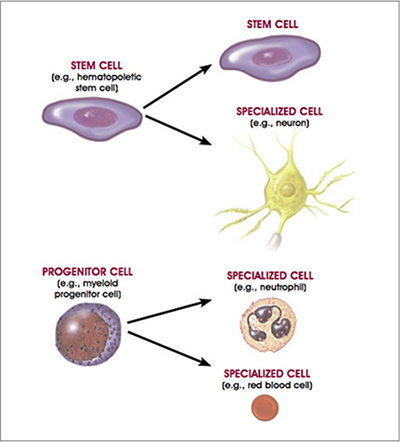STEM CELL
A stem cell is a “blank” cell that has not yet made up its mind as to what it is going to be. “Stem cells have the remarkable potential to develop into many different cell types in the body. Serving as a sort of repair system for the body, they can theoretically divide without limit to replenish other cells as long as the person is still alive. When a stem cell divides, each new cell has the potential to either remain a stem cell or become another type of cell with a more specialized function, such as a muscle cell, a red blood cell, or a brain cell.”
Adult Stem Cells
Adult stem cells are predominantly formed in the bone marrow. And, just as in the beginnings of life, adult stem cells can literally change into any type of cell in the body throughout life. These adult stem cells are released from the bone marrow into the circulation of the bloodstream to seek out problem areas, then renew and restore those areas.
Adult stem cells have been identified in many organs and tissues, including brain, bone marrow, peripheral blood, blood vessels, skeletal muscle, skin, teeth, heart, gut, liver, ovarian epithelium, and testis. They are thought to reside in a specific area of each tissue (called a "stem cell niche”). Stem cells may remain quiescent (non-dividing) for long periods of time until they are activated by a normal need for more cells to maintain tissues, or by disease or tissue injury.
Adult Stem Cells therapy holds the key to unlocking the anti-aging fountain of youth we’ve all been wishing for. You can turn back the clock with their own adult stem cells therapies naturally.
Distinguishing Features of Progenitor/Precursor Cells and Stem Cells.
A stem cell is an unspecialized cell that is capable of replicating or self renewing itself and developing into specialized cells of a variety of cell types. The product of a stem cell undergoing division is at least one additional stem cell that has the same capabilities of the originating cell. Shown here is an example of a hematopoietic stem cell producing a second generation stem cell and a neuron. A progenitor cell (also known as a precursor cell) is unspecialized or has partial characteristics of a specialized cell that is capable of undergoing cell division and yielding two specialized cells. Shown here is an example of a myeloid progenitor/precursor undergoing cell division to yield two specialized cells (a neutrophil and a red blood cell).
Adult Stem Cell Plasticity
It was not until recently that anyone seriously considered the possibility that stem cells in adult tissues could generate the specialized cell types of another type of tissue from which they normally reside—either a tissue derived from the same embryonic germ layer or from a different germ layer. For example, studies have shown that blood stem cells (derived from mesoderm) may be able to generate both skeletal muscle (also derived from mesoderm) and neurons (derived from ectoderm). That realization has been triggered by a flurry of papers reporting that stem cells derived from one adult tissue can change their appearance and assume characteristics that resemble those of differentiated cells from other tissues.
The term plasticity, as used in this report, means that a stem cell from one adult tissue can generate the differentiated cell types of another tissue. At this time, there is no formally accepted name for this phenomenon in the scientific literature. It is variously referred to as "plasticity", "unorthodox differentiation" or "transdifferentiation".



